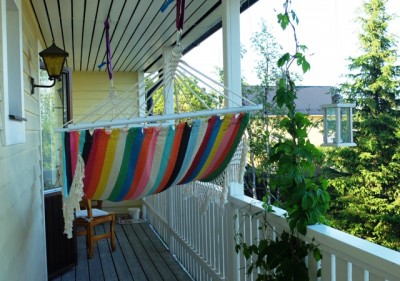We’ve been away for two months and hardly recognise the place we left. It isn’t just that the snow has gone, more that our world has been turned upside down. It’s 27 degrees of heat in a verdant, buzzing landscape where the sun (literally) never sets. The once silent frozen land is teeming with life – flowers, grasses, bushes, birds, insects.
Ah yes, the insects – let me count the ways. The familiar mosquito: it buzzes as it comes by, and I’m told that the bite doesn’t itch afterwards if you don’t disturb it while it’s feeding, but who can watch it suck their blood and just let it be? The ubiquitous midge: an arctic variant of a Scottish favourite. It doesn’t buzz, but settles gently around the face and neck unleashing little hills of itchy unpleasantness. The humble fly: in this part of the world known to bite, mainly detested for its sheer insistence. The horse fly: usually moves in a pack, has the most fearsome bite of all so even the thought of it is enough to make me quiver.
Generally speaking insects don’t bother us immediately around the house, appearing to respect it as our territory, but as soon as we step out into the overgrown grass beyond then it seems we’re fair game. When we left here two months ago we had a garden of snow, and sometime when that snow melted there must have been a brief period when it almost looked like a garden, or at least like a backyard. But long hours of daylight make greenery leap, so the garden is now an untamed nature reserve, with areas of wild meadow and tall grass, full of insects and wildlife. Sooner or later this has to be cut, but it’s already too late for a lawnmower, it’s far too high. A scythe is the only answer. We’ll work and work on it over the next month, and we’ll only just get it to a manageable height by the end of the summer, just before the snow comes again.
With insects in residence, tackling this jungle requires full protective clothing and a net over the head, which is not my idea of gardening in 27 degrees of heat. I’ve not been keen to get started.
There’s a stretch of decking running the width of our house, between us and the garden, with white painted wooden railings in front of it. Our neighbour tells us that locally this is called ‘the bridge’. When people arrive at the house they must come onto the bridge before they can knock on the door. As it’s a wooden house we hear their impending arrival a few seconds before the knock. They are on our house, but not in it.
The bridge is long enough for a short promenade, if you walk slowly and turn every minute. It’s the place for surveying but not really engaging with the outside world. Like the captain of a ship, on the bridge we give careful thought to the tasks ahead. The bridge is the place from which a ship – or in our case, our home – is commanded.
Running parallel to our bridge is our neighbour’s bridge. Far enough away not to be intrusive, but close enough to feel you aren’t alone at sea. Being on a hill we can look down from our bridge, or we can look sideways, to a neighbouring ship. Our neighbour often stands on her bridge in the night, watching her dog sniff the air, companionably observing the sky and distant land. We may still be up, reading, or talking quietly on our bridge. Sometimes we’ll wave to each other; ships passing in the night.
In these warm days which are literally never ending, the bridge is the place to be. In the evenings we eat there, looking out over the challenge which is our garden. The hares come out later, having no help from fading light it’s easy to watch them. There are young hares too, running between the bushes. It’s so hard to make the decision to go to bed when it’s always light and the sky has the promise of the continuing day.
We’ve just installed a hammock on our bridge. It’s perfect for being rocked to and fro in the breeze, for appreciating the time before starting something, the time that is in between.


